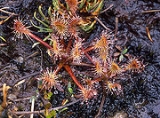
Drosera stenopetala
Encyclopedia
Drosera stenopetala is an insectivorous
, rosette
-forming perennial
sub-alpine or alpine herb
. The specific epithet means "with narrow petals", which is somewhat misleading given that the petals of this plant are fairly wide. A species of sundew, it is unique within its genus in being endemic to New Zealand
. It is one of New Zealand's two alpine species of Drosera, the other being Drosera arcturi
. Characteristic features include involute (inwardly curved) petiole
s and upright leaves. Its range extends from the Ruahine
and Tararua Ranges in the north down the Southern Alps
to Stewart Island. It is also found on the Auckland Islands
and Campbell Island
.
Carnivorous plant
Carnivorous plants are plants that derive some or most of their nutrients from trapping and consuming animals or protozoans, typically insects and other arthropods. Carnivorous plants appear adapted to grow in places where the soil is thin or poor in nutrients, especially nitrogen, such as acidic...
, rosette
Rosette (botany)
In botany, a rosette is a circular arrangement of leaves, with all the leaves at a single height.Though rosettes usually sit near the soil, their structure is an example of a modified stem.-Function:...
-forming perennial
Perennial plant
A perennial plant or simply perennial is a plant that lives for more than two years. The term is often used to differentiate a plant from shorter lived annuals and biennials. The term is sometimes misused by commercial gardeners or horticulturalists to describe only herbaceous perennials...
sub-alpine or alpine herb
Herbaceous
A herbaceous plant is a plant that has leaves and stems that die down at the end of the growing season to the soil level. They have no persistent woody stem above ground...
. The specific epithet means "with narrow petals", which is somewhat misleading given that the petals of this plant are fairly wide. A species of sundew, it is unique within its genus in being endemic to New Zealand
New Zealand
New Zealand is an island country in the south-western Pacific Ocean comprising two main landmasses and numerous smaller islands. The country is situated some east of Australia across the Tasman Sea, and roughly south of the Pacific island nations of New Caledonia, Fiji, and Tonga...
. It is one of New Zealand's two alpine species of Drosera, the other being Drosera arcturi
Drosera arcturi
Drosera arcturi is a perennial, insectivorous species of sub-alpine or alpine herb native to Australia and New Zealand. It is one of New Zealand's two alpine species of sundew, the other being Drosera stenopetala.The specific epithet, which translates as "of Arthur" from Latin, is a reference to...
. Characteristic features include involute (inwardly curved) petiole
Petiole (botany)
In botany, the petiole is the stalk attaching the leaf blade to the stem. The petiole usually has the same internal structure as the stem. Outgrowths appearing on each side of the petiole are called stipules. Leaves lacking a petiole are called sessile, or clasping when they partly surround the...
s and upright leaves. Its range extends from the Ruahine
Ruahine Range
The Ruahine Range is one of several mountain ranges in the North Island of New Zealand which form a ridge running parallel with the east coast of the island between East Cape and Wellington....
and Tararua Ranges in the north down the Southern Alps
Southern Alps
The Southern Alps is a mountain range extending along much of the length of New Zealand's South Island, reaching its greatest elevations near the island's western side...
to Stewart Island. It is also found on the Auckland Islands
Auckland Islands
The Auckland Islands are an archipelago of the New Zealand Sub-Antarctic Islands and include Auckland Island, Adams Island, Enderby Island, Disappointment Island, Ewing Island, Rose Island, Dundas Island and Green Island, with a combined area of...
and Campbell Island
Campbell Island, New Zealand
Campbell Island is a remote, subantarctic island of New Zealand and the main island of the Campbell Island group. It covers of the group's , and is surrounded by numerous stacks, rocks and islets like Dent Island, Folly Island , Isle de Jeanette Marie, and Jacquemart Island, the latter being the...
.

